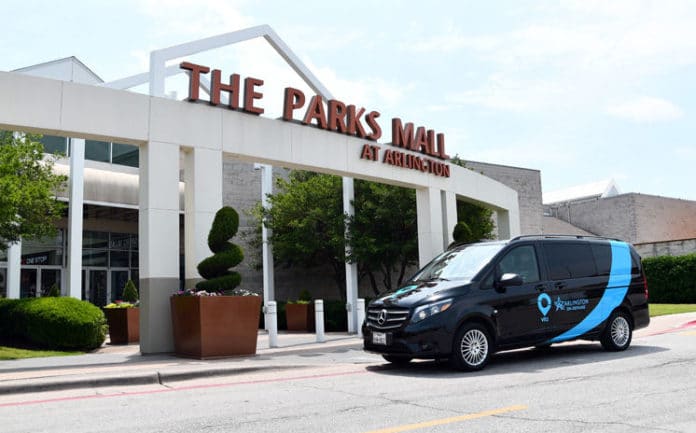TRANSIT DESERT: Definition: An area that has high demand for transit but lacks access to high-quality public transportation, meaning that it is more than a half-mile from a rail stop and a quarter-mile from high-quality bus service.
Arlington’s status as the most populous city in the country without a conventional mass transportation system might well be under challenge. With 400,000 people, Arlington ranks 48th nationally; that’s more people than in New Orleans, Buffalo, Cleveland or St. Louis.
The city is, after all, the first Texas municipality to implement a driverless cars system – Drive.ai – although that year-long pilot program is confined to the Entertainment District. The city also gets credit for implementing a well-used and nationally applauded on-call phone app van pickup system called Via, which now has logged more than 100,000 rides and is steadily expanding its service area in the city’s sprawling 100 square miles.
That much accomplished, recent media coverage labeling Arlington a transit desert must be discouraging to the powers-that-be in the city, though from this perspective they deserve kudos for being innovative with limited resources and minimal public support for conventional transit systems.
TRANSIT DESERT: Definition: An area that has high demand for transit but lacks access to high-quality public transportation, meaning that it is more than a half-mile from a rail stop and a quarter-mile from high-quality bus service.
That part about “high demand” is definitely debatable given the history. Arlington voters turned down a bus line enthusiastically on three occasions in the modern era – 1980, 1995 and 2002 – despite endorsements by influential community leaders and media. The rest of that definition, however, absolutely fits.
Oddly, Arlington came into being as a Texas and Pacific rail station stop and for a half century had passenger train service – but no more. Amtrak goes through but doesn’t stop. Likewise, for more than three decades the city had an electric trolley system rolling through the middle of it, connecting to both Fort Worth and Dallas in less than 30 minutes. That’s also long gone.
Census data indicate Arlington is among the nation’s leaders for population commuting out of the city to work, with more than 100,000 on work days. The traffic is not all one way. Almost that many people commute into the city as well, almost all by private automobile, leaving a pollution footprint of enormous size and a need for vast, wasteful parking areas.
Boiled down to its basics, voters have historically looked at past mass transit proposals not as a city-building enhancement but from a more basic perspective: Will this work if I need to go somewhere and get there soon?
Voters mostly thought not, declining to use sales tax resources for a service they had no plan to use. So auto-oriented is the city that resistance often occurs where there are attempts to slow traffic. Arlington voters, for instance, two years ago voted to eliminate red light traffic cameras.
Another issue: Cities mostly use discretionary sales tax revenue to fund mass transit and Arlington has invested most of its such funds in professional sports development.
The most recent pundit to endorse the idea of Arlington as a transit desert is University of Texas at Arlington Professor Diane Jones Allen, director of landscape architecture as well as author of a hot new transportation dilemma book, Lost in the Transit Desert.
Allen likes what Arlington has done so far but she doesn’t see Via or driverless vehicles as the answer to a huge range of urban problems including traffic congestion, social inequality, air quality impact and climate change, and an often-overlooked need that should appeal to just about everybody: economic development, as in jobs creation and dollars flowing along with lifestyle improvements.
This requires, she contends, more conventional, far-reaching mass transit.
She also offers a couple of potentially useful ideas, beginning with a different appeal to voters.
Idea I. “Sell mass transit as an economic driver that enhances population density, producing development, jobs and a live/work/play environment. It helps create a more robust economy that floats everybody’s boat.”
Idea II: “Arlington is ripe for developing TOD districts (transit-oriented development), starting with downtown and areas like the Highlands/Parks Mall area.”
TOD? That’s a type of urban development that maximizes residential, business and leisure space within walking distance of public transport, which might also include separate protected lanes for bicycles or electric scooters. Or small driverless vehicles. A TOD would likely also be combined with a tax increment district or business improvement district.
Allen sees Arlington as a great place to try those ideas.
“If leadership can get people to make the connection between mass transit, employment and growth, higher density and creation of a live-work-play community life will eventually follow,” she says. “Arlington has a great deal of positivity and can have just as much development with better transit design and without auto and commuting reliance.”
http://uta.academia.edu/DianeJonesAllen
O.K. Carter is a former editor and publisher of the Arlington Citizen-Journal and was also Arlington publisher and columnist for the Star-Telegram and founding editor of Arlington Today Magazine. He’s the author of the definitive book on Arlington’s colorful history, Caddos, Cotton and Cowboys: Essays on Arlington.
okcarter@bizpress.net






